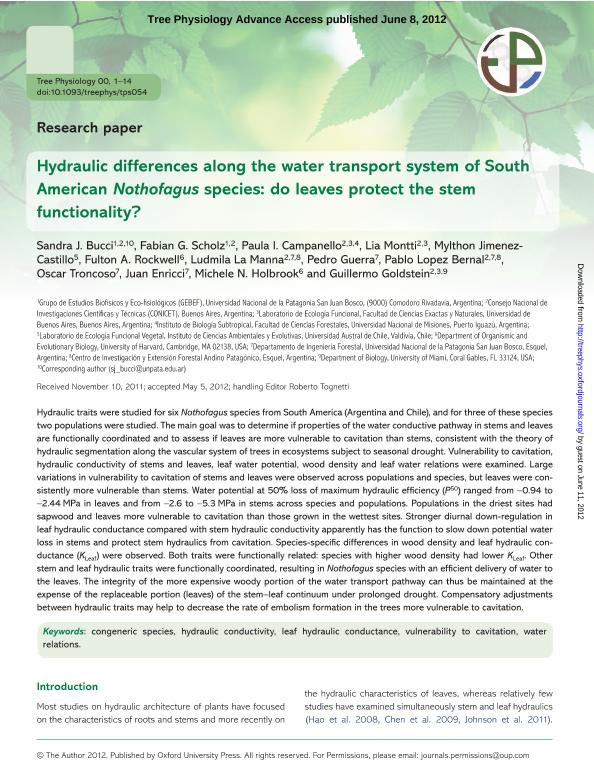Mostrar el registro sencillo del ítem
dc.contributor.author
Bucci, Sandra Janet

dc.contributor.author
Scholz, Fabian Gustavo

dc.contributor.author
Campanello, Paula Inés

dc.contributor.author
Montti, Lia Fernanda

dc.contributor.author
Jimenez Castillo, Mylthon
dc.contributor.author
Rockwell, Fulton A.
dc.contributor.author
la Manna, Ludmila Andrea

dc.contributor.author
Guerra, Pedro
dc.contributor.author
Lopez Bernal, Pablo Martin

dc.contributor.author
Troncoso, Oscar Alberto

dc.contributor.author
Enricci, Juan
dc.contributor.author
Holbrook, Michele N.
dc.contributor.author
Goldstein, Guillermo Hernan

dc.date.available
2018-12-14T17:37:46Z
dc.date.issued
2012-07
dc.identifier.citation
Bucci, Sandra Janet; Scholz, Fabian Gustavo; Campanello, Paula Inés; Montti, Lia Fernanda; Jimenez Castillo, Mylthon; et al.; Hydraulic differences along the water transport system of South American Nothofagus species: Do leaves protect the stem functionality?; Oxford University Press; Tree Physiology; 32; 7; 7-2012; 880-893
dc.identifier.issn
0829-318X
dc.identifier.uri
http://hdl.handle.net/11336/66508
dc.description.abstract
Hydraulic traits were studied for six Nothofagus species from South America (Argentina and Chile), and for three of these species two populations were studied. The main goal was to determine if properties of the water conductive pathway in stems and leaves are functionally coordinated and to assess if leaves are more vulnerable to cavitation than stems, consistent with the theory of hydraulic segmentation along the vascular system of trees in ecosystems subject to seasonal drought. Vulnerability to cavitation, hydraulic conductivity of stems and leaves, leaf water potential, wood density and leaf water relations were examined. Large variations in vulnerability to cavitation of stems and leaves were observed across populations and species, but leaves were consistently more vulnerable than stems. Water potential at 50 loss of maximum hydraulic efficiency (P50) ranged from-0.94 to-2.44MPa in leaves and from-2.6 to-5.3MPa in stems across species and populations. Populations in the driest sites had sapwood and leaves more vulnerable to cavitation than those grown in the wettest sites. Stronger diurnal down-regulation in leaf hydraulic conductance compared with stem hydraulic conductivity apparently has the function to slow down potential water loss in stems and protect stem hydraulics from cavitation. Species-specific differences in wood density and leaf hydraulic conductance (KLeaf) were observed. Both traits were functionally related: species with higher wood density had lower KLeaf. Other stem and leaf hydraulic traits were functionally coordinated, resulting in Nothofagus species with an efficient delivery of water to the leaves. The integrity of the more expensive woody portion of the water transport pathway can thus be maintained at the expense of the replaceable portion (leaves) of the stem-leaf continuum under prolonged drought. Compensatory adjustments between hydraulic traits may help to decrease the rate of embolism formation in the trees more vulnerable to cavitation. © 2012 The Author.
dc.format
application/pdf
dc.language.iso
eng
dc.publisher
Oxford University Press

dc.rights
info:eu-repo/semantics/openAccess
dc.rights.uri
https://creativecommons.org/licenses/by-nc-sa/2.5/ar/
dc.subject
Congeneric Species
dc.subject
Hydraulic Conductivity
dc.subject
Leaf Hydraulic Conductance
dc.subject
Vulnerability to Cavitation
dc.subject
Water Relations
dc.subject.classification
Otras Ciencias Biológicas

dc.subject.classification
Ciencias Biológicas

dc.subject.classification
CIENCIAS NATURALES Y EXACTAS

dc.title
Hydraulic differences along the water transport system of South American Nothofagus species: Do leaves protect the stem functionality?
dc.type
info:eu-repo/semantics/article
dc.type
info:ar-repo/semantics/artículo
dc.type
info:eu-repo/semantics/publishedVersion
dc.date.updated
2018-12-05T14:35:56Z
dc.journal.volume
32
dc.journal.number
7
dc.journal.pagination
880-893
dc.journal.pais
Reino Unido

dc.journal.ciudad
Oxford
dc.description.fil
Fil: Bucci, Sandra Janet. Consejo Nacional de Investigaciones Científicas y Técnicas; Argentina. Universidad Nacional de la Patagonia; Argentina
dc.description.fil
Fil: Scholz, Fabian Gustavo. Consejo Nacional de Investigaciones Científicas y Técnicas; Argentina. Universidad Nacional de la Patagonia; Argentina
dc.description.fil
Fil: Campanello, Paula Inés. Consejo Nacional de Investigaciones Científicas y Técnicas; Argentina. Universidad de Buenos Aires. Facultad de Ciencias Exactas y Naturales. Departamento de Ecología, Genética y Evolución. Laboratorio de Ecología Funcional; Argentina. Consejo Nacional de Investigaciones Científicas y Técnicas. Centro Científico Tecnológico Conicet - Nordeste. Instituto de Biología Subtropical. Instituto de Biología Subtropical - Nodo Puerto Iguazú | Universidad Nacional de Misiones. Instituto de Biología Subtropical. Instituto de Biología Subtropical - Nodo Puerto Iguazú; Argentina
dc.description.fil
Fil: Montti, Lia Fernanda. Consejo Nacional de Investigaciones Científicas y Técnicas; Argentina. Universidad de Buenos Aires. Facultad de Ciencias Exactas y Naturales. Departamento de Ecología, Genética y Evolución. Laboratorio de Ecología Funcional; Argentina
dc.description.fil
Fil: Jimenez Castillo, Mylthon. Universidad Austral de Chile; Chile
dc.description.fil
Fil: Rockwell, Fulton A.. Harvard University; Estados Unidos
dc.description.fil
Fil: la Manna, Ludmila Andrea. Consejo Nacional de Investigaciones Científicas y Técnicas; Argentina. Universidad Nacional de la Patagonia "san Juan Bosco". Facultad de Ingeniería - Sede Esquel. Departamento de Ingeniería Forestal; Argentina. Provincia del Chubut. Centro de Investigación y Extensión Forestal Andino Patagónico; Argentina
dc.description.fil
Fil: Guerra, Pedro. Universidad Nacional de la Patagonia "san Juan Bosco". Facultad de Ingeniería - Sede Esquel. Departamento de Ingeniería Forestal; Argentina
dc.description.fil
Fil: Lopez Bernal, Pablo Martin. Consejo Nacional de Investigaciones Científicas y Técnicas; Argentina. Universidad Nacional de la Patagonia "san Juan Bosco". Facultad de Ingeniería - Sede Esquel. Departamento de Ingeniería Forestal; Argentina. Provincia del Chubut. Centro de Investigación y Extensión Forestal Andino Patagónico; Argentina
dc.description.fil
Fil: Troncoso, Oscar Alberto. Universidad Nacional de la Patagonia "san Juan Bosco". Facultad de Ingeniería - Sede Esquel. Departamento de Ingeniería Forestal; Argentina
dc.description.fil
Fil: Enricci, Juan. Universidad Nacional de la Patagonia "san Juan Bosco". Facultad de Ingeniería - Sede Esquel. Departamento de Ingeniería Forestal; Argentina
dc.description.fil
Fil: Holbrook, Michele N.. Harvard University; Estados Unidos
dc.description.fil
Fil: Goldstein, Guillermo Hernan. Consejo Nacional de Investigaciones Científicas y Técnicas; Argentina. Universidad de Buenos Aires. Facultad de Ciencias Exactas y Naturales. Departamento de Ecología, Genética y Evolución. Laboratorio de Ecología Funcional; Argentina. University of Miami; Estados Unidos
dc.journal.title
Tree Physiology

dc.relation.alternativeid
info:eu-repo/semantics/altIdentifier/doi/https://doi.org/10.1093/treephys/tps054
dc.relation.alternativeid
info:eu-repo/semantics/altIdentifier/url/https://academic.oup.com/treephys/article/32/7/880/1644561
Archivos asociados
